Comprehensive Environmental Impact Assessment: I-77 Toll Lanes
VerifiedAdded on 2023/05/29
|22
|3948
|386
Report
AI Summary
This report presents an Environmental Impact Assessment (EIA) for the I-77 Toll Lanes project near Charlotte, North Carolina, focusing on the project's potential environmental consequences. The assessment identifies key environmental concerns, including ozone pollution, vegetation and wildlife impact, and adherence to environmental regulations such as the Clean Air Act and noise pollution limits. It provides a detailed description of the environment, including soil types, geologic hazards, hydrology, ecology, and valued ecosystem components (VECs). The report also covers impact management strategies, significance determination, and recommendations for mitigation, such as lighting strategies and buffer spaces. The assessment concludes with suggestions for future research, emphasizing the need for broader boundaries and mixed data collection methods to enhance the EIA's comprehensiveness. Desklib offers a platform for students to access this and other solved assignments.

1
Running head: ENVIRONMENTAL IMPACT ASSESSMENT OF I-77 TOLL LANES
ENVIRONMENTAL IMPACT ASSESSMENT OF I-77 TOLL
LANES
[Author]
[Institution]
Running head: ENVIRONMENTAL IMPACT ASSESSMENT OF I-77 TOLL LANES
ENVIRONMENTAL IMPACT ASSESSMENT OF I-77 TOLL
LANES
[Author]
[Institution]
Paraphrase This Document
Need a fresh take? Get an instant paraphrase of this document with our AI Paraphraser
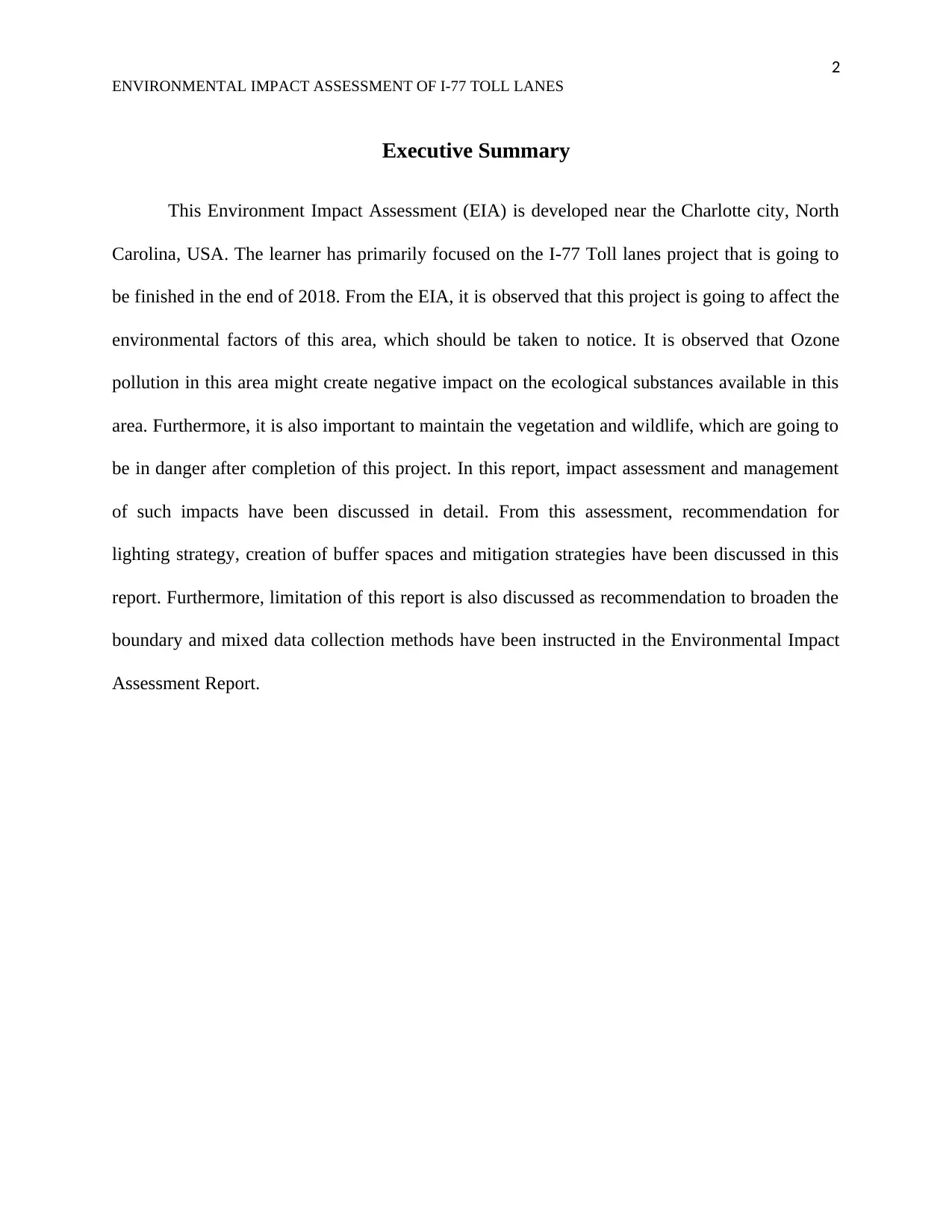
2
ENVIRONMENTAL IMPACT ASSESSMENT OF I-77 TOLL LANES
Executive Summary
This Environment Impact Assessment (EIA) is developed near the Charlotte city, North
Carolina, USA. The learner has primarily focused on the I-77 Toll lanes project that is going to
be finished in the end of 2018. From the EIA, it is observed that this project is going to affect the
environmental factors of this area, which should be taken to notice. It is observed that Ozone
pollution in this area might create negative impact on the ecological substances available in this
area. Furthermore, it is also important to maintain the vegetation and wildlife, which are going to
be in danger after completion of this project. In this report, impact assessment and management
of such impacts have been discussed in detail. From this assessment, recommendation for
lighting strategy, creation of buffer spaces and mitigation strategies have been discussed in this
report. Furthermore, limitation of this report is also discussed as recommendation to broaden the
boundary and mixed data collection methods have been instructed in the Environmental Impact
Assessment Report.
ENVIRONMENTAL IMPACT ASSESSMENT OF I-77 TOLL LANES
Executive Summary
This Environment Impact Assessment (EIA) is developed near the Charlotte city, North
Carolina, USA. The learner has primarily focused on the I-77 Toll lanes project that is going to
be finished in the end of 2018. From the EIA, it is observed that this project is going to affect the
environmental factors of this area, which should be taken to notice. It is observed that Ozone
pollution in this area might create negative impact on the ecological substances available in this
area. Furthermore, it is also important to maintain the vegetation and wildlife, which are going to
be in danger after completion of this project. In this report, impact assessment and management
of such impacts have been discussed in detail. From this assessment, recommendation for
lighting strategy, creation of buffer spaces and mitigation strategies have been discussed in this
report. Furthermore, limitation of this report is also discussed as recommendation to broaden the
boundary and mixed data collection methods have been instructed in the Environmental Impact
Assessment Report.
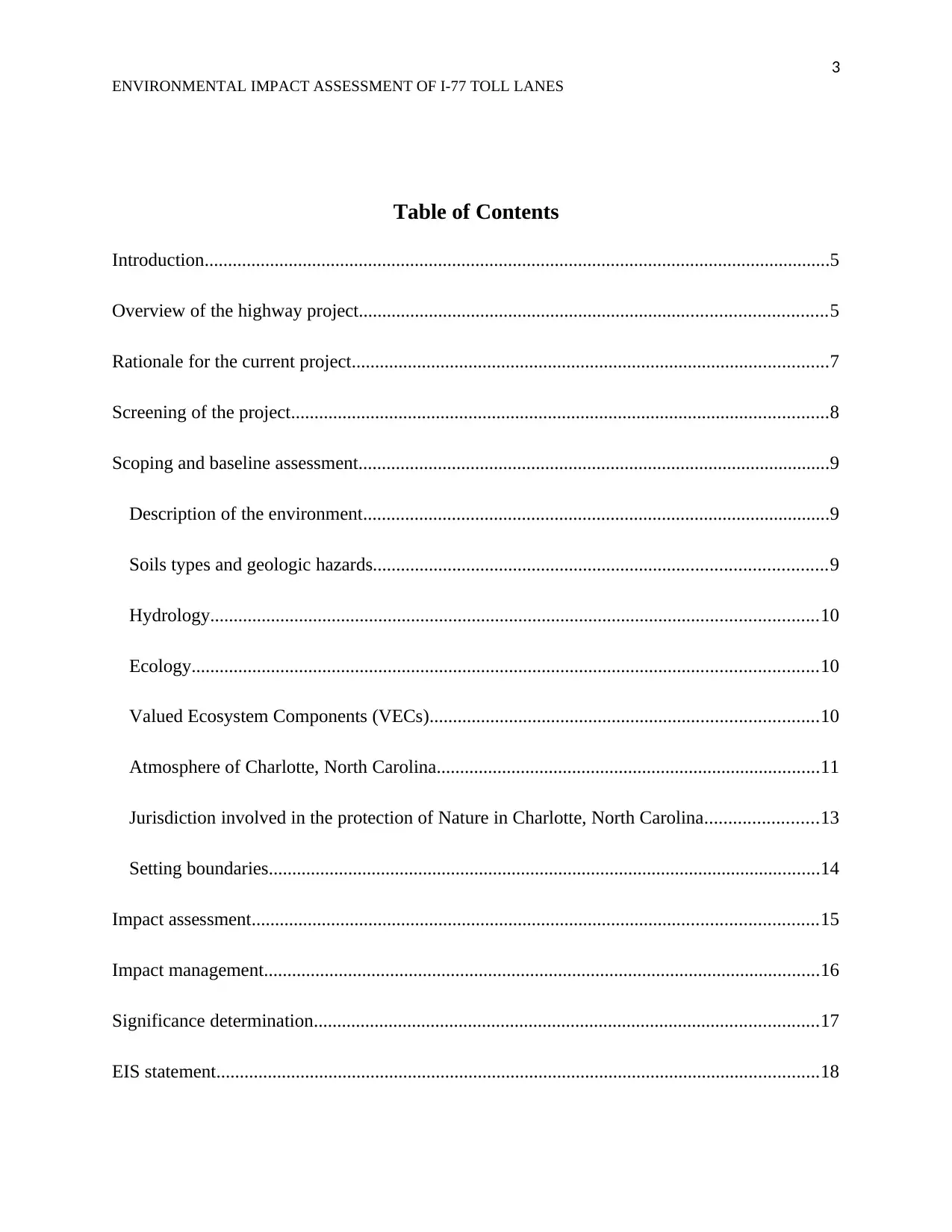
3
ENVIRONMENTAL IMPACT ASSESSMENT OF I-77 TOLL LANES
Table of Contents
Introduction......................................................................................................................................5
Overview of the highway project....................................................................................................5
Rationale for the current project......................................................................................................7
Screening of the project...................................................................................................................8
Scoping and baseline assessment.....................................................................................................9
Description of the environment....................................................................................................9
Soils types and geologic hazards.................................................................................................9
Hydrology..................................................................................................................................10
Ecology......................................................................................................................................10
Valued Ecosystem Components (VECs)...................................................................................10
Atmosphere of Charlotte, North Carolina..................................................................................11
Jurisdiction involved in the protection of Nature in Charlotte, North Carolina........................13
Setting boundaries......................................................................................................................14
Impact assessment.........................................................................................................................15
Impact management.......................................................................................................................16
Significance determination............................................................................................................17
EIS statement.................................................................................................................................18
ENVIRONMENTAL IMPACT ASSESSMENT OF I-77 TOLL LANES
Table of Contents
Introduction......................................................................................................................................5
Overview of the highway project....................................................................................................5
Rationale for the current project......................................................................................................7
Screening of the project...................................................................................................................8
Scoping and baseline assessment.....................................................................................................9
Description of the environment....................................................................................................9
Soils types and geologic hazards.................................................................................................9
Hydrology..................................................................................................................................10
Ecology......................................................................................................................................10
Valued Ecosystem Components (VECs)...................................................................................10
Atmosphere of Charlotte, North Carolina..................................................................................11
Jurisdiction involved in the protection of Nature in Charlotte, North Carolina........................13
Setting boundaries......................................................................................................................14
Impact assessment.........................................................................................................................15
Impact management.......................................................................................................................16
Significance determination............................................................................................................17
EIS statement.................................................................................................................................18
⊘ This is a preview!⊘
Do you want full access?
Subscribe today to unlock all pages.

Trusted by 1+ million students worldwide

4
ENVIRONMENTAL IMPACT ASSESSMENT OF I-77 TOLL LANES
Recommendations and decision....................................................................................................18
Implementation and follow-up......................................................................................................19
Reference List................................................................................................................................20
ENVIRONMENTAL IMPACT ASSESSMENT OF I-77 TOLL LANES
Recommendations and decision....................................................................................................18
Implementation and follow-up......................................................................................................19
Reference List................................................................................................................................20
Paraphrase This Document
Need a fresh take? Get an instant paraphrase of this document with our AI Paraphraser
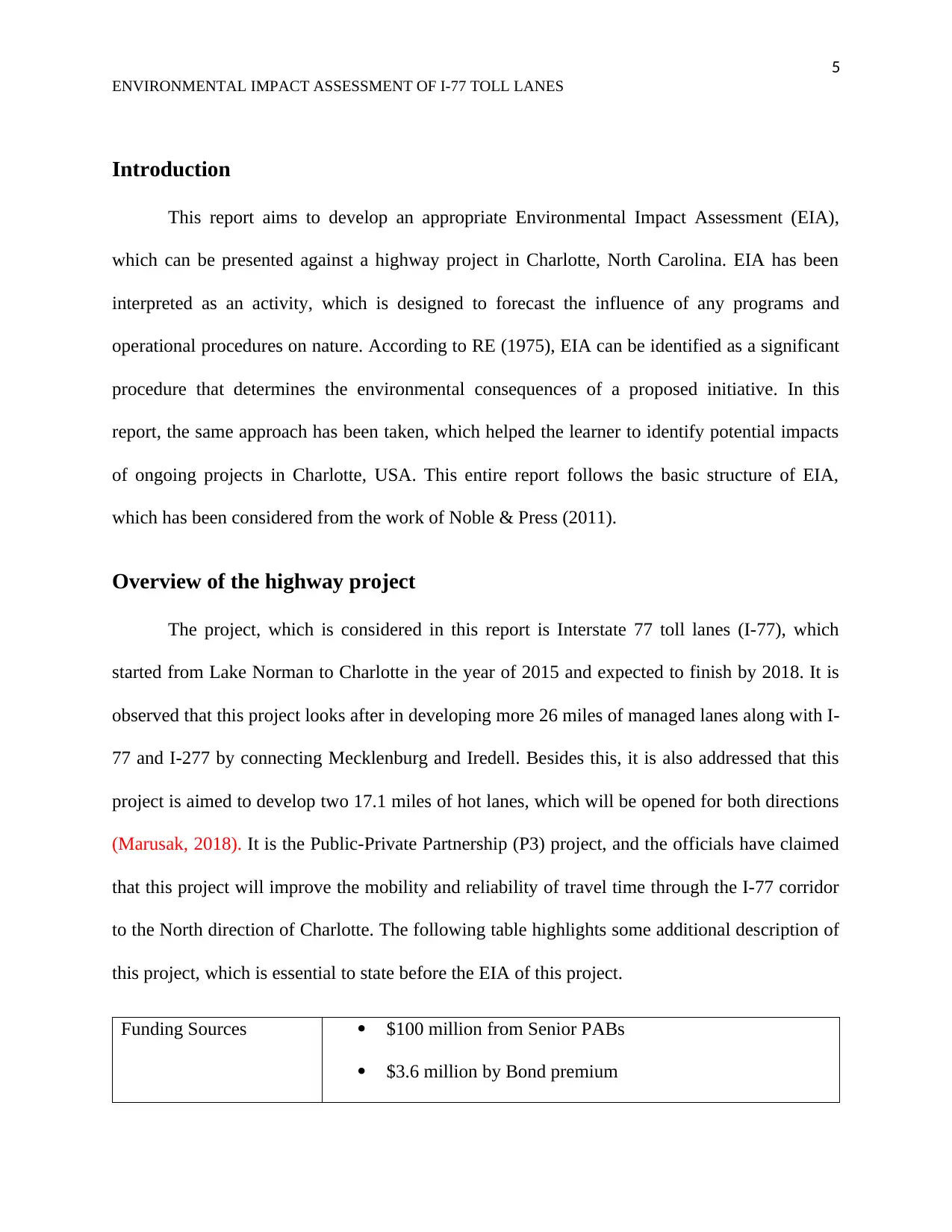
5
ENVIRONMENTAL IMPACT ASSESSMENT OF I-77 TOLL LANES
Introduction
This report aims to develop an appropriate Environmental Impact Assessment (EIA),
which can be presented against a highway project in Charlotte, North Carolina. EIA has been
interpreted as an activity, which is designed to forecast the influence of any programs and
operational procedures on nature. According to RE (1975), EIA can be identified as a significant
procedure that determines the environmental consequences of a proposed initiative. In this
report, the same approach has been taken, which helped the learner to identify potential impacts
of ongoing projects in Charlotte, USA. This entire report follows the basic structure of EIA,
which has been considered from the work of Noble & Press (2011).
Overview of the highway project
The project, which is considered in this report is Interstate 77 toll lanes (I-77), which
started from Lake Norman to Charlotte in the year of 2015 and expected to finish by 2018. It is
observed that this project looks after in developing more 26 miles of managed lanes along with I-
77 and I-277 by connecting Mecklenburg and Iredell. Besides this, it is also addressed that this
project is aimed to develop two 17.1 miles of hot lanes, which will be opened for both directions
(Marusak, 2018). It is the Public-Private Partnership (P3) project, and the officials have claimed
that this project will improve the mobility and reliability of travel time through the I-77 corridor
to the North direction of Charlotte. The following table highlights some additional description of
this project, which is essential to state before the EIA of this project.
Funding Sources $100 million from Senior PABs
$3.6 million by Bond premium
ENVIRONMENTAL IMPACT ASSESSMENT OF I-77 TOLL LANES
Introduction
This report aims to develop an appropriate Environmental Impact Assessment (EIA),
which can be presented against a highway project in Charlotte, North Carolina. EIA has been
interpreted as an activity, which is designed to forecast the influence of any programs and
operational procedures on nature. According to RE (1975), EIA can be identified as a significant
procedure that determines the environmental consequences of a proposed initiative. In this
report, the same approach has been taken, which helped the learner to identify potential impacts
of ongoing projects in Charlotte, USA. This entire report follows the basic structure of EIA,
which has been considered from the work of Noble & Press (2011).
Overview of the highway project
The project, which is considered in this report is Interstate 77 toll lanes (I-77), which
started from Lake Norman to Charlotte in the year of 2015 and expected to finish by 2018. It is
observed that this project looks after in developing more 26 miles of managed lanes along with I-
77 and I-277 by connecting Mecklenburg and Iredell. Besides this, it is also addressed that this
project is aimed to develop two 17.1 miles of hot lanes, which will be opened for both directions
(Marusak, 2018). It is the Public-Private Partnership (P3) project, and the officials have claimed
that this project will improve the mobility and reliability of travel time through the I-77 corridor
to the North direction of Charlotte. The following table highlights some additional description of
this project, which is essential to state before the EIA of this project.
Funding Sources $100 million from Senior PABs
$3.6 million by Bond premium
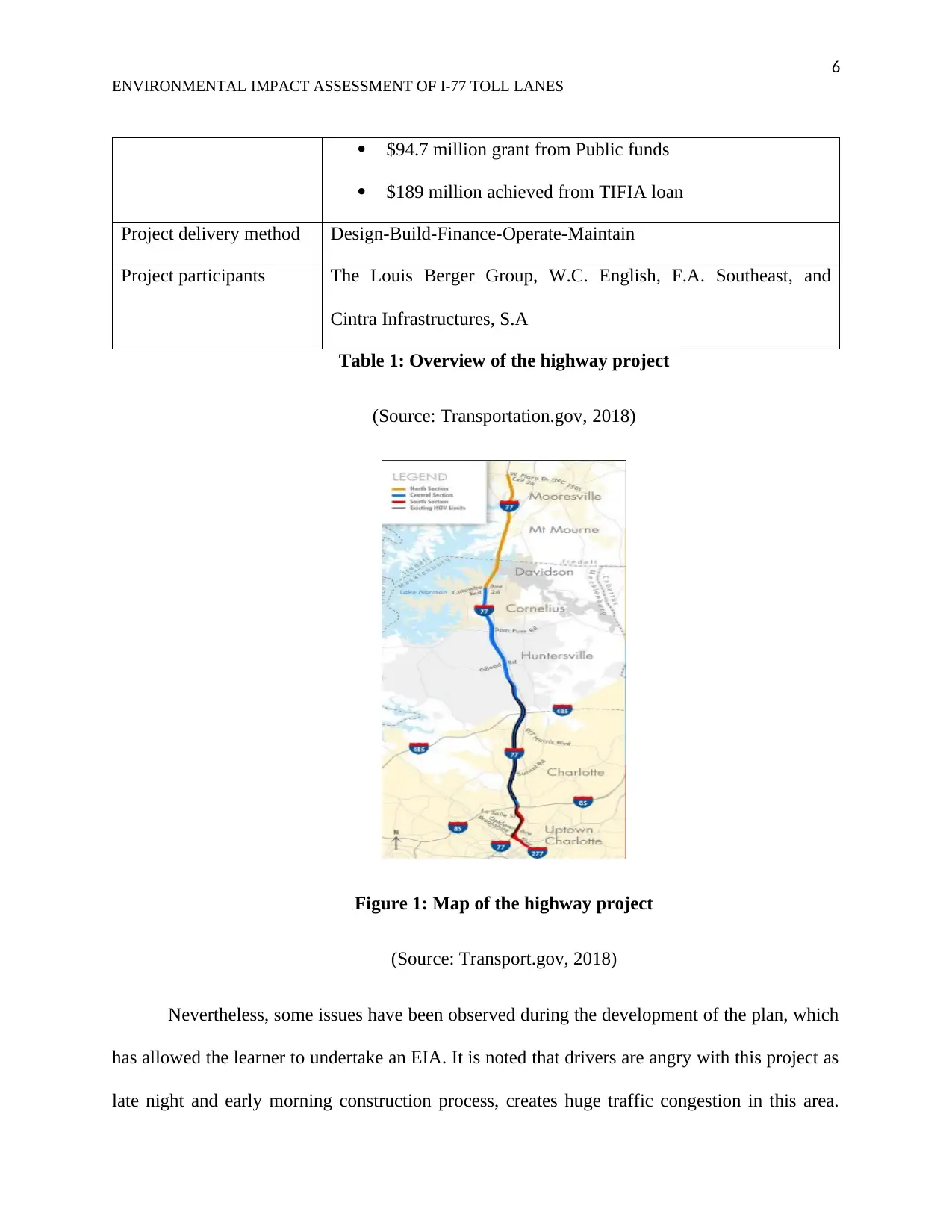
6
ENVIRONMENTAL IMPACT ASSESSMENT OF I-77 TOLL LANES
$94.7 million grant from Public funds
$189 million achieved from TIFIA loan
Project delivery method Design-Build-Finance-Operate-Maintain
Project participants The Louis Berger Group, W.C. English, F.A. Southeast, and
Cintra Infrastructures, S.A
Table 1: Overview of the highway project
(Source: Transportation.gov, 2018)
Figure 1: Map of the highway project
(Source: Transport.gov, 2018)
Nevertheless, some issues have been observed during the development of the plan, which
has allowed the learner to undertake an EIA. It is noted that drivers are angry with this project as
late night and early morning construction process, creates huge traffic congestion in this area.
ENVIRONMENTAL IMPACT ASSESSMENT OF I-77 TOLL LANES
$94.7 million grant from Public funds
$189 million achieved from TIFIA loan
Project delivery method Design-Build-Finance-Operate-Maintain
Project participants The Louis Berger Group, W.C. English, F.A. Southeast, and
Cintra Infrastructures, S.A
Table 1: Overview of the highway project
(Source: Transportation.gov, 2018)
Figure 1: Map of the highway project
(Source: Transport.gov, 2018)
Nevertheless, some issues have been observed during the development of the plan, which
has allowed the learner to undertake an EIA. It is noted that drivers are angry with this project as
late night and early morning construction process, creates huge traffic congestion in this area.
⊘ This is a preview!⊘
Do you want full access?
Subscribe today to unlock all pages.

Trusted by 1+ million students worldwide
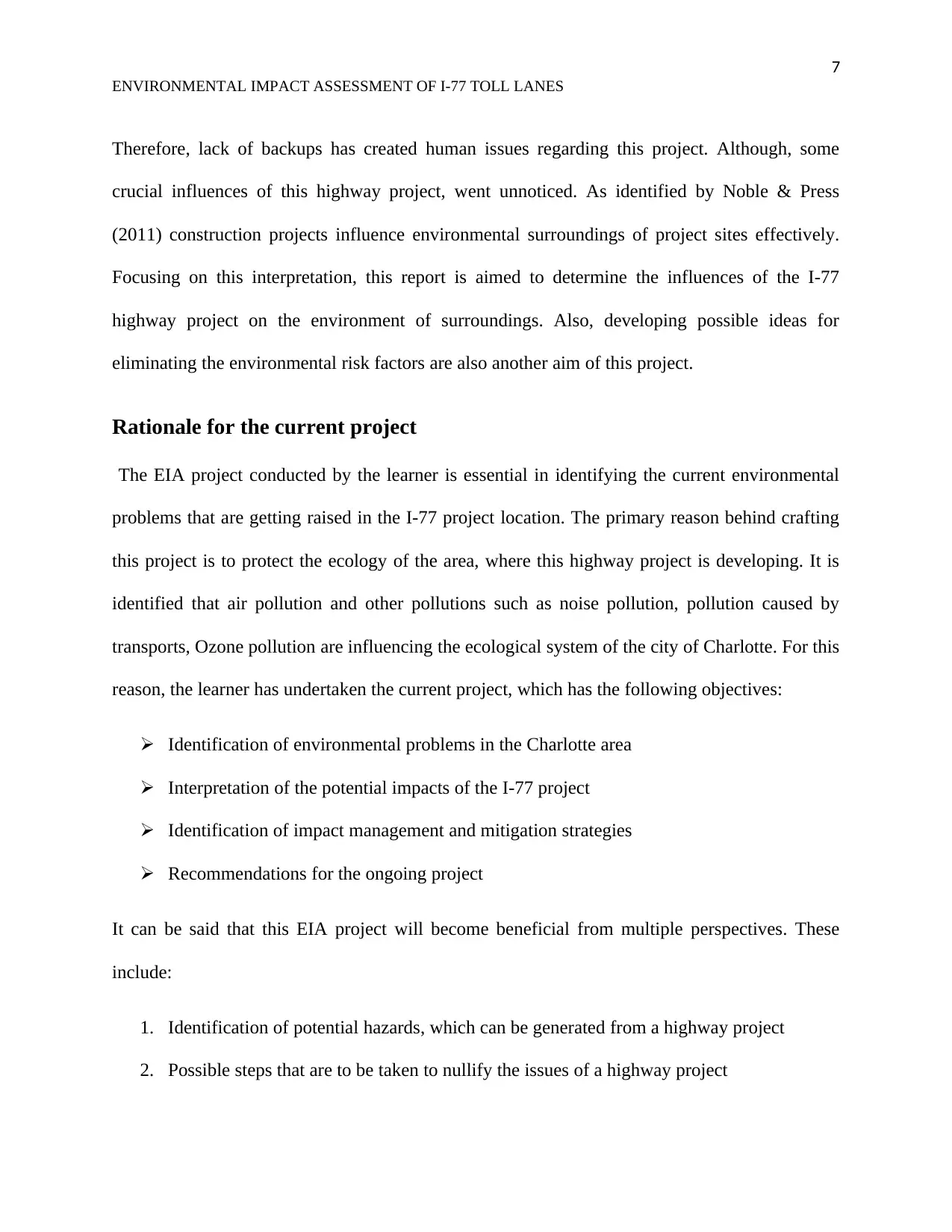
7
ENVIRONMENTAL IMPACT ASSESSMENT OF I-77 TOLL LANES
Therefore, lack of backups has created human issues regarding this project. Although, some
crucial influences of this highway project, went unnoticed. As identified by Noble & Press
(2011) construction projects influence environmental surroundings of project sites effectively.
Focusing on this interpretation, this report is aimed to determine the influences of the I-77
highway project on the environment of surroundings. Also, developing possible ideas for
eliminating the environmental risk factors are also another aim of this project.
Rationale for the current project
The EIA project conducted by the learner is essential in identifying the current environmental
problems that are getting raised in the I-77 project location. The primary reason behind crafting
this project is to protect the ecology of the area, where this highway project is developing. It is
identified that air pollution and other pollutions such as noise pollution, pollution caused by
transports, Ozone pollution are influencing the ecological system of the city of Charlotte. For this
reason, the learner has undertaken the current project, which has the following objectives:
Identification of environmental problems in the Charlotte area
Interpretation of the potential impacts of the I-77 project
Identification of impact management and mitigation strategies
Recommendations for the ongoing project
It can be said that this EIA project will become beneficial from multiple perspectives. These
include:
1. Identification of potential hazards, which can be generated from a highway project
2. Possible steps that are to be taken to nullify the issues of a highway project
ENVIRONMENTAL IMPACT ASSESSMENT OF I-77 TOLL LANES
Therefore, lack of backups has created human issues regarding this project. Although, some
crucial influences of this highway project, went unnoticed. As identified by Noble & Press
(2011) construction projects influence environmental surroundings of project sites effectively.
Focusing on this interpretation, this report is aimed to determine the influences of the I-77
highway project on the environment of surroundings. Also, developing possible ideas for
eliminating the environmental risk factors are also another aim of this project.
Rationale for the current project
The EIA project conducted by the learner is essential in identifying the current environmental
problems that are getting raised in the I-77 project location. The primary reason behind crafting
this project is to protect the ecology of the area, where this highway project is developing. It is
identified that air pollution and other pollutions such as noise pollution, pollution caused by
transports, Ozone pollution are influencing the ecological system of the city of Charlotte. For this
reason, the learner has undertaken the current project, which has the following objectives:
Identification of environmental problems in the Charlotte area
Interpretation of the potential impacts of the I-77 project
Identification of impact management and mitigation strategies
Recommendations for the ongoing project
It can be said that this EIA project will become beneficial from multiple perspectives. These
include:
1. Identification of potential hazards, which can be generated from a highway project
2. Possible steps that are to be taken to nullify the issues of a highway project
Paraphrase This Document
Need a fresh take? Get an instant paraphrase of this document with our AI Paraphraser
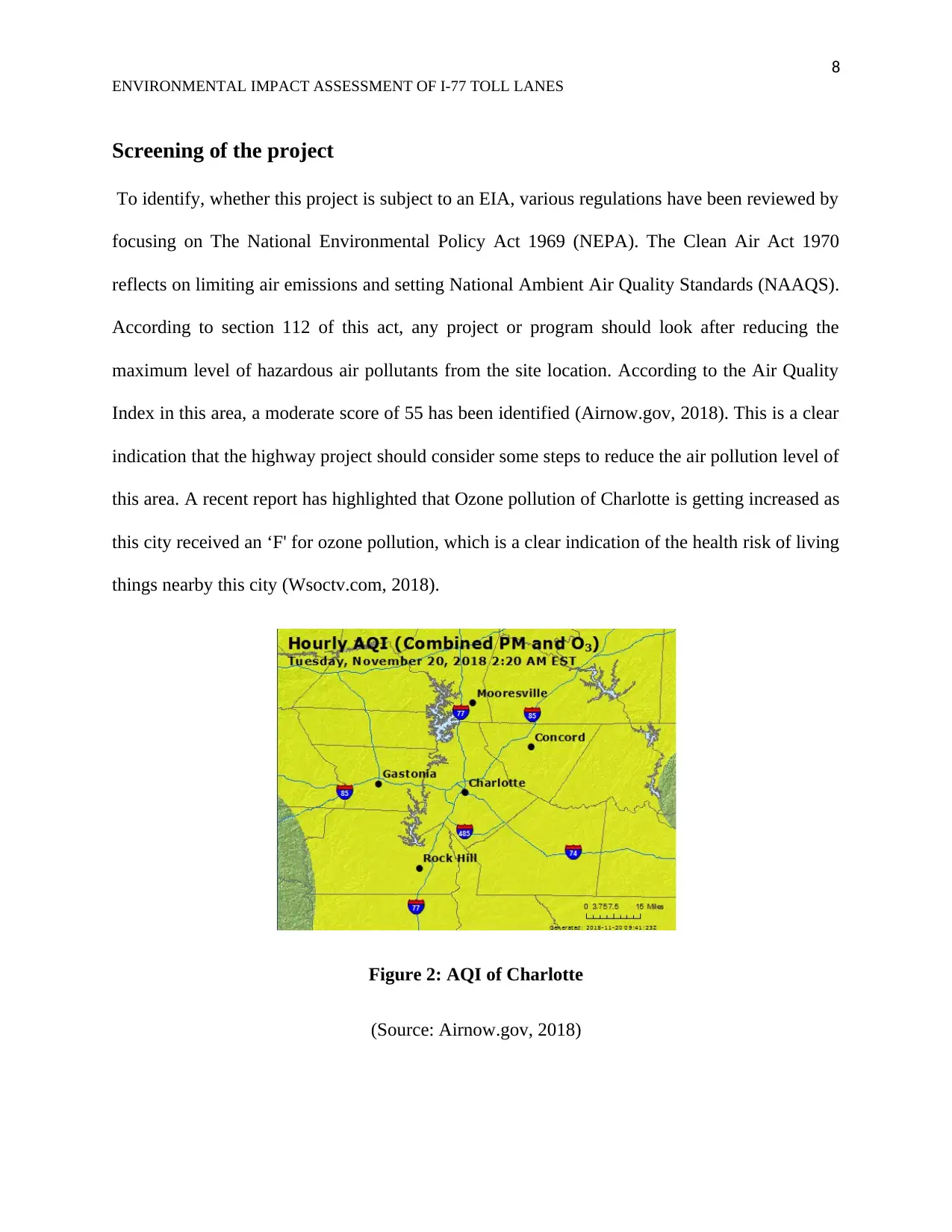
8
ENVIRONMENTAL IMPACT ASSESSMENT OF I-77 TOLL LANES
Screening of the project
To identify, whether this project is subject to an EIA, various regulations have been reviewed by
focusing on The National Environmental Policy Act 1969 (NEPA). The Clean Air Act 1970
reflects on limiting air emissions and setting National Ambient Air Quality Standards (NAAQS).
According to section 112 of this act, any project or program should look after reducing the
maximum level of hazardous air pollutants from the site location. According to the Air Quality
Index in this area, a moderate score of 55 has been identified (Airnow.gov, 2018). This is a clear
indication that the highway project should consider some steps to reduce the air pollution level of
this area. A recent report has highlighted that Ozone pollution of Charlotte is getting increased as
this city received an ‘F' for ozone pollution, which is a clear indication of the health risk of living
things nearby this city (Wsoctv.com, 2018).
Figure 2: AQI of Charlotte
(Source: Airnow.gov, 2018)
ENVIRONMENTAL IMPACT ASSESSMENT OF I-77 TOLL LANES
Screening of the project
To identify, whether this project is subject to an EIA, various regulations have been reviewed by
focusing on The National Environmental Policy Act 1969 (NEPA). The Clean Air Act 1970
reflects on limiting air emissions and setting National Ambient Air Quality Standards (NAAQS).
According to section 112 of this act, any project or program should look after reducing the
maximum level of hazardous air pollutants from the site location. According to the Air Quality
Index in this area, a moderate score of 55 has been identified (Airnow.gov, 2018). This is a clear
indication that the highway project should consider some steps to reduce the air pollution level of
this area. A recent report has highlighted that Ozone pollution of Charlotte is getting increased as
this city received an ‘F' for ozone pollution, which is a clear indication of the health risk of living
things nearby this city (Wsoctv.com, 2018).
Figure 2: AQI of Charlotte
(Source: Airnow.gov, 2018)
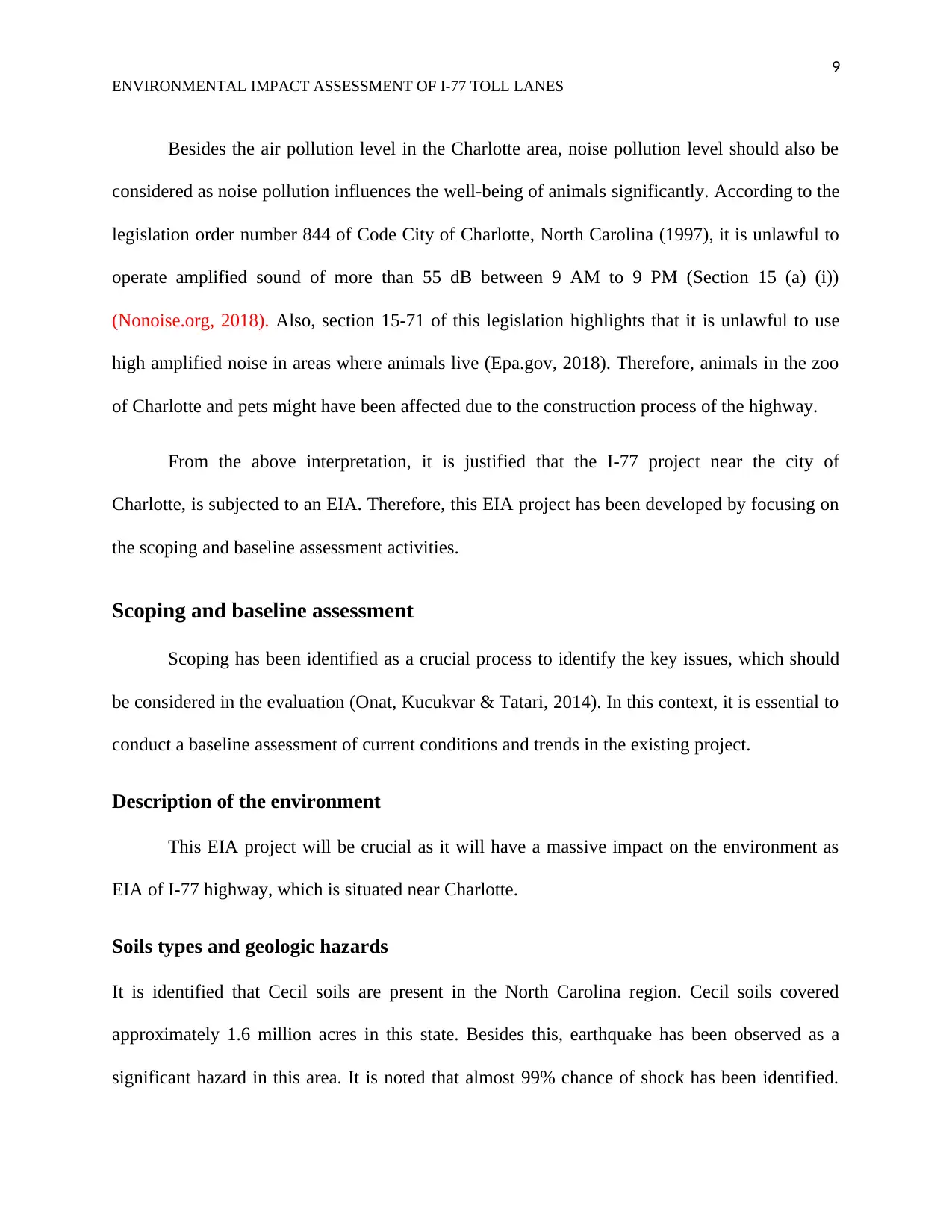
9
ENVIRONMENTAL IMPACT ASSESSMENT OF I-77 TOLL LANES
Besides the air pollution level in the Charlotte area, noise pollution level should also be
considered as noise pollution influences the well-being of animals significantly. According to the
legislation order number 844 of Code City of Charlotte, North Carolina (1997), it is unlawful to
operate amplified sound of more than 55 dB between 9 AM to 9 PM (Section 15 (a) (i))
(Nonoise.org, 2018). Also, section 15-71 of this legislation highlights that it is unlawful to use
high amplified noise in areas where animals live (Epa.gov, 2018). Therefore, animals in the zoo
of Charlotte and pets might have been affected due to the construction process of the highway.
From the above interpretation, it is justified that the I-77 project near the city of
Charlotte, is subjected to an EIA. Therefore, this EIA project has been developed by focusing on
the scoping and baseline assessment activities.
Scoping and baseline assessment
Scoping has been identified as a crucial process to identify the key issues, which should
be considered in the evaluation (Onat, Kucukvar & Tatari, 2014). In this context, it is essential to
conduct a baseline assessment of current conditions and trends in the existing project.
Description of the environment
This EIA project will be crucial as it will have a massive impact on the environment as
EIA of I-77 highway, which is situated near Charlotte.
Soils types and geologic hazards
It is identified that Cecil soils are present in the North Carolina region. Cecil soils covered
approximately 1.6 million acres in this state. Besides this, earthquake has been observed as a
significant hazard in this area. It is noted that almost 99% chance of shock has been identified.
ENVIRONMENTAL IMPACT ASSESSMENT OF I-77 TOLL LANES
Besides the air pollution level in the Charlotte area, noise pollution level should also be
considered as noise pollution influences the well-being of animals significantly. According to the
legislation order number 844 of Code City of Charlotte, North Carolina (1997), it is unlawful to
operate amplified sound of more than 55 dB between 9 AM to 9 PM (Section 15 (a) (i))
(Nonoise.org, 2018). Also, section 15-71 of this legislation highlights that it is unlawful to use
high amplified noise in areas where animals live (Epa.gov, 2018). Therefore, animals in the zoo
of Charlotte and pets might have been affected due to the construction process of the highway.
From the above interpretation, it is justified that the I-77 project near the city of
Charlotte, is subjected to an EIA. Therefore, this EIA project has been developed by focusing on
the scoping and baseline assessment activities.
Scoping and baseline assessment
Scoping has been identified as a crucial process to identify the key issues, which should
be considered in the evaluation (Onat, Kucukvar & Tatari, 2014). In this context, it is essential to
conduct a baseline assessment of current conditions and trends in the existing project.
Description of the environment
This EIA project will be crucial as it will have a massive impact on the environment as
EIA of I-77 highway, which is situated near Charlotte.
Soils types and geologic hazards
It is identified that Cecil soils are present in the North Carolina region. Cecil soils covered
approximately 1.6 million acres in this state. Besides this, earthquake has been observed as a
significant hazard in this area. It is noted that almost 99% chance of shock has been identified.
⊘ This is a preview!⊘
Do you want full access?
Subscribe today to unlock all pages.

Trusted by 1+ million students worldwide
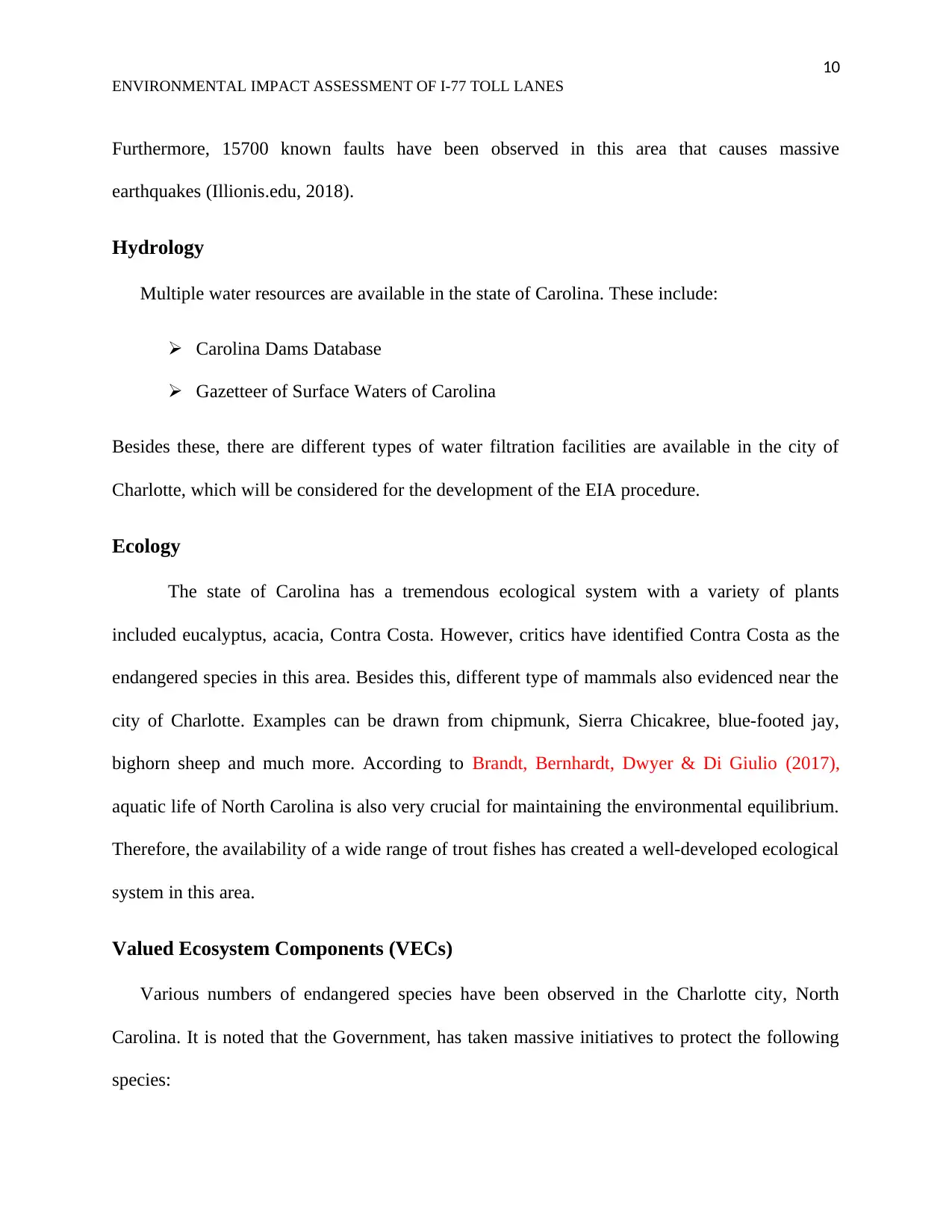
10
ENVIRONMENTAL IMPACT ASSESSMENT OF I-77 TOLL LANES
Furthermore, 15700 known faults have been observed in this area that causes massive
earthquakes (Illionis.edu, 2018).
Hydrology
Multiple water resources are available in the state of Carolina. These include:
Carolina Dams Database
Gazetteer of Surface Waters of Carolina
Besides these, there are different types of water filtration facilities are available in the city of
Charlotte, which will be considered for the development of the EIA procedure.
Ecology
The state of Carolina has a tremendous ecological system with a variety of plants
included eucalyptus, acacia, Contra Costa. However, critics have identified Contra Costa as the
endangered species in this area. Besides this, different type of mammals also evidenced near the
city of Charlotte. Examples can be drawn from chipmunk, Sierra Chicakree, blue-footed jay,
bighorn sheep and much more. According to Brandt, Bernhardt, Dwyer & Di Giulio (2017),
aquatic life of North Carolina is also very crucial for maintaining the environmental equilibrium.
Therefore, the availability of a wide range of trout fishes has created a well-developed ecological
system in this area.
Valued Ecosystem Components (VECs)
Various numbers of endangered species have been observed in the Charlotte city, North
Carolina. It is noted that the Government, has taken massive initiatives to protect the following
species:
ENVIRONMENTAL IMPACT ASSESSMENT OF I-77 TOLL LANES
Furthermore, 15700 known faults have been observed in this area that causes massive
earthquakes (Illionis.edu, 2018).
Hydrology
Multiple water resources are available in the state of Carolina. These include:
Carolina Dams Database
Gazetteer of Surface Waters of Carolina
Besides these, there are different types of water filtration facilities are available in the city of
Charlotte, which will be considered for the development of the EIA procedure.
Ecology
The state of Carolina has a tremendous ecological system with a variety of plants
included eucalyptus, acacia, Contra Costa. However, critics have identified Contra Costa as the
endangered species in this area. Besides this, different type of mammals also evidenced near the
city of Charlotte. Examples can be drawn from chipmunk, Sierra Chicakree, blue-footed jay,
bighorn sheep and much more. According to Brandt, Bernhardt, Dwyer & Di Giulio (2017),
aquatic life of North Carolina is also very crucial for maintaining the environmental equilibrium.
Therefore, the availability of a wide range of trout fishes has created a well-developed ecological
system in this area.
Valued Ecosystem Components (VECs)
Various numbers of endangered species have been observed in the Charlotte city, North
Carolina. It is noted that the Government, has taken massive initiatives to protect the following
species:
Paraphrase This Document
Need a fresh take? Get an instant paraphrase of this document with our AI Paraphraser
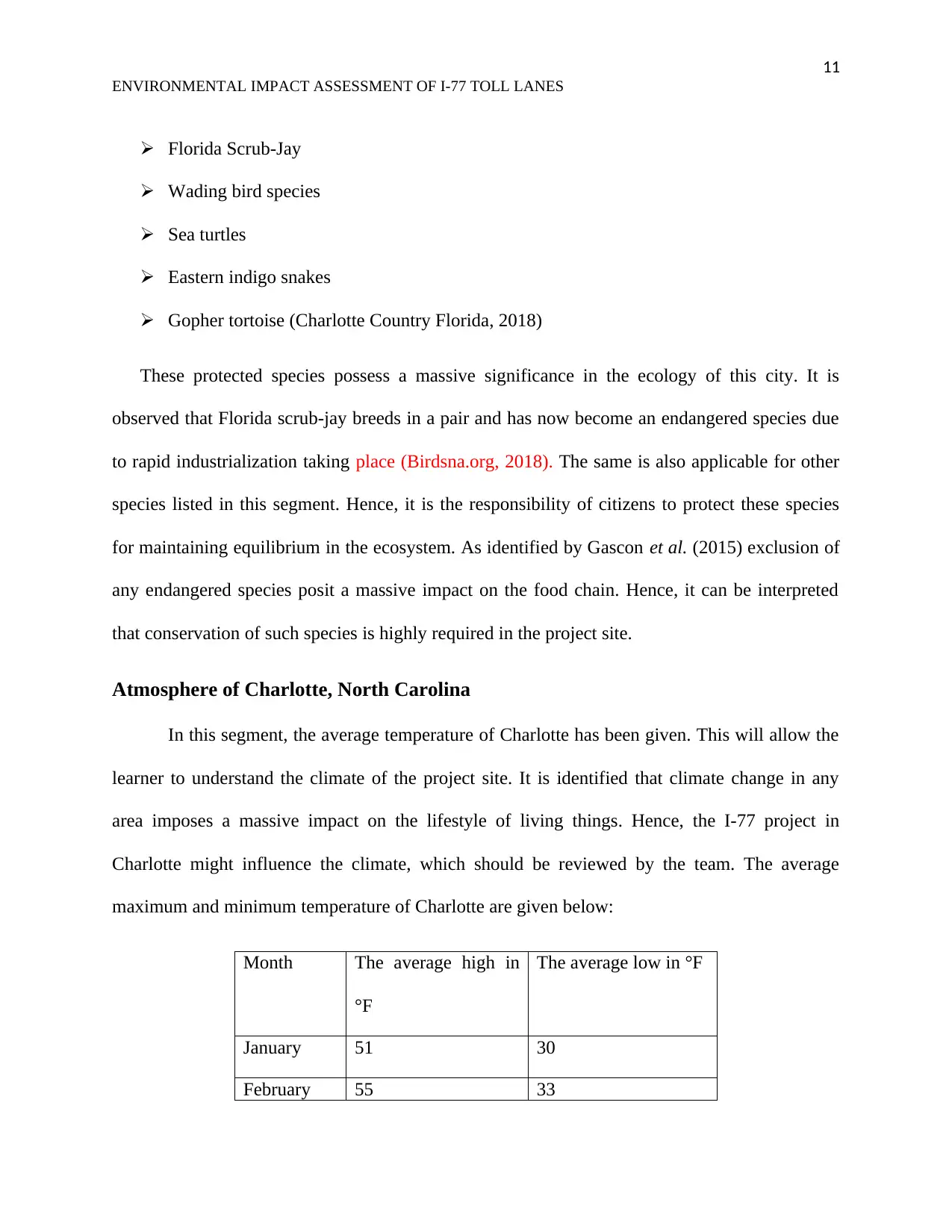
11
ENVIRONMENTAL IMPACT ASSESSMENT OF I-77 TOLL LANES
Florida Scrub-Jay
Wading bird species
Sea turtles
Eastern indigo snakes
Gopher tortoise (Charlotte Country Florida, 2018)
These protected species possess a massive significance in the ecology of this city. It is
observed that Florida scrub-jay breeds in a pair and has now become an endangered species due
to rapid industrialization taking place (Birdsna.org, 2018). The same is also applicable for other
species listed in this segment. Hence, it is the responsibility of citizens to protect these species
for maintaining equilibrium in the ecosystem. As identified by Gascon et al. (2015) exclusion of
any endangered species posit a massive impact on the food chain. Hence, it can be interpreted
that conservation of such species is highly required in the project site.
Atmosphere of Charlotte, North Carolina
In this segment, the average temperature of Charlotte has been given. This will allow the
learner to understand the climate of the project site. It is identified that climate change in any
area imposes a massive impact on the lifestyle of living things. Hence, the I-77 project in
Charlotte might influence the climate, which should be reviewed by the team. The average
maximum and minimum temperature of Charlotte are given below:
Month The average high in
°F
The average low in °F
January 51 30
February 55 33
ENVIRONMENTAL IMPACT ASSESSMENT OF I-77 TOLL LANES
Florida Scrub-Jay
Wading bird species
Sea turtles
Eastern indigo snakes
Gopher tortoise (Charlotte Country Florida, 2018)
These protected species possess a massive significance in the ecology of this city. It is
observed that Florida scrub-jay breeds in a pair and has now become an endangered species due
to rapid industrialization taking place (Birdsna.org, 2018). The same is also applicable for other
species listed in this segment. Hence, it is the responsibility of citizens to protect these species
for maintaining equilibrium in the ecosystem. As identified by Gascon et al. (2015) exclusion of
any endangered species posit a massive impact on the food chain. Hence, it can be interpreted
that conservation of such species is highly required in the project site.
Atmosphere of Charlotte, North Carolina
In this segment, the average temperature of Charlotte has been given. This will allow the
learner to understand the climate of the project site. It is identified that climate change in any
area imposes a massive impact on the lifestyle of living things. Hence, the I-77 project in
Charlotte might influence the climate, which should be reviewed by the team. The average
maximum and minimum temperature of Charlotte are given below:
Month The average high in
°F
The average low in °F
January 51 30
February 55 33
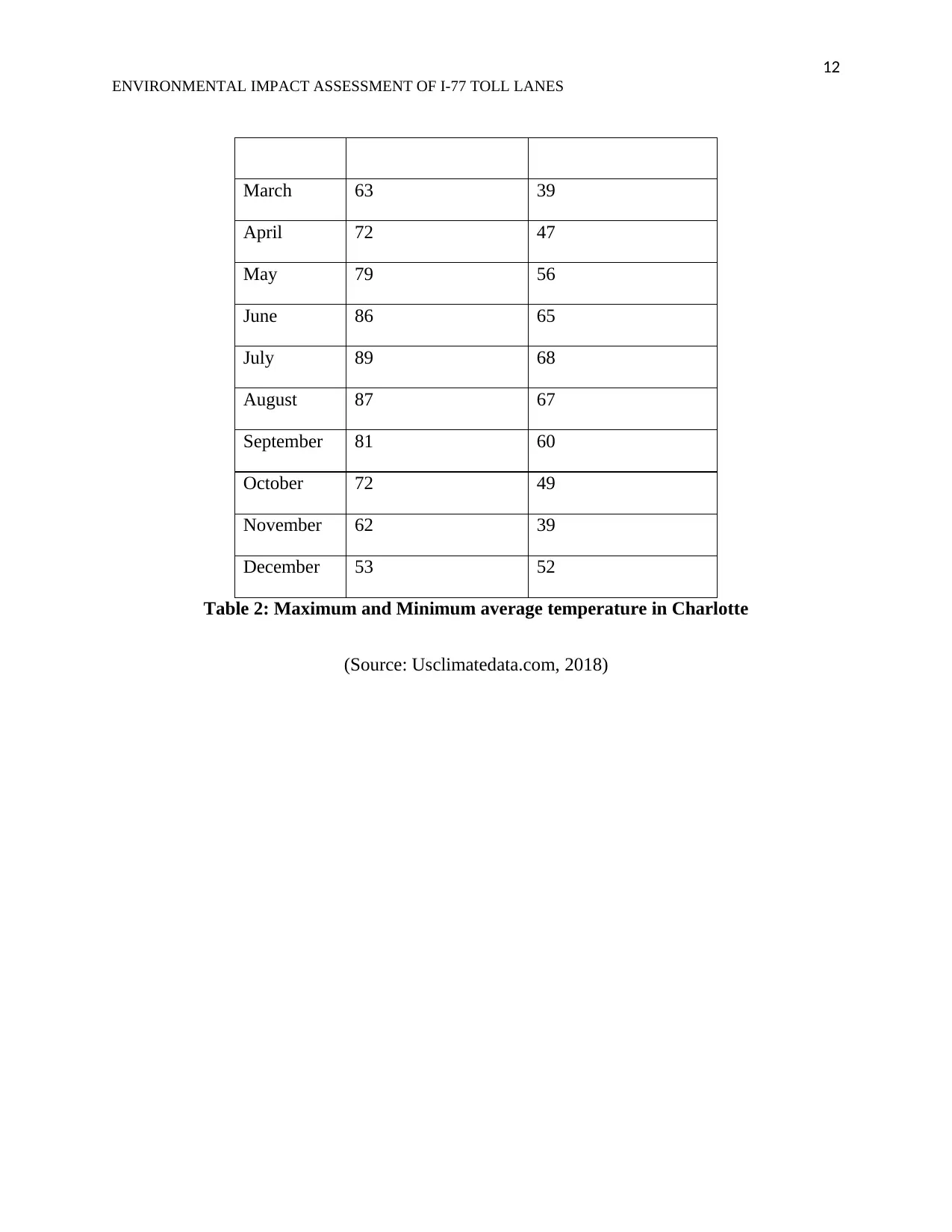
12
ENVIRONMENTAL IMPACT ASSESSMENT OF I-77 TOLL LANES
March 63 39
April 72 47
May 79 56
June 86 65
July 89 68
August 87 67
September 81 60
October 72 49
November 62 39
December 53 52
Table 2: Maximum and Minimum average temperature in Charlotte
(Source: Usclimatedata.com, 2018)
ENVIRONMENTAL IMPACT ASSESSMENT OF I-77 TOLL LANES
March 63 39
April 72 47
May 79 56
June 86 65
July 89 68
August 87 67
September 81 60
October 72 49
November 62 39
December 53 52
Table 2: Maximum and Minimum average temperature in Charlotte
(Source: Usclimatedata.com, 2018)
⊘ This is a preview!⊘
Do you want full access?
Subscribe today to unlock all pages.

Trusted by 1+ million students worldwide
1 out of 22
Your All-in-One AI-Powered Toolkit for Academic Success.
+13062052269
info@desklib.com
Available 24*7 on WhatsApp / Email
![[object Object]](/_next/static/media/star-bottom.7253800d.svg)
Unlock your academic potential
Copyright © 2020–2025 A2Z Services. All Rights Reserved. Developed and managed by ZUCOL.
